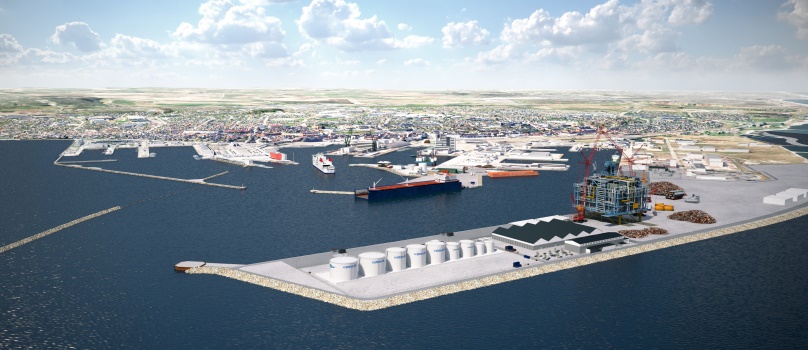ABOUT THE PORT EXPANSION
THE PORT OF THE FUTURE
More and deeper harbour basins, more quays, wider entrance and significant extended hinterland areas. That is how the future looks for Frederikshavn.
On August 26, 2015 the Port of Frederikshavn made an agreement on the port expansion with Per Aarsleff A/S.
STAGE 1 |
| 330,000 M2 HINTERLAND AREA |
| 30,000 M2 QUAY FACILITIES |
| 600 M QUAY |
| 11 M WATER DEPTH - PREPARED FOR 14 M |
The expansion has turned out to be a very wise strategy. The Port of Frederikshavn is close to being able to announce that all areas and capacities included in stage 1 are sold out. In order to continue the development of the port’s activities and implement ongoing projects with both new and existing customers, another capacity expansion was decided upon in October 2017 - Stage 2.
STAGE 2 |
| 170,000 M2 HINTERLAND AREA |
| 400 M QUAY |
| 14 M WATER DEPTH |
| SHIP RAMP |
| SKIDDING AREA |
The future expansion redefines the concept of the “one-stop shop”. It will then be possible to strengthen business areas such as the offshore industry, oil, gas & wind, biomass, LNG and environmentally correct scrapping of ships and oil rigs.

NEED FOR DEVELOPMENT
The Port of Frederikshavn and the nearly 100 private companies operating at the port have experienced great success and are therefore demanding bigger and better harbour facilities. Their increased capacity needs were confirmed in a survey involving twelve of the biggest maritime service companies at the port. For this reason major steps were taken in 2012 to plan and design a large-scale expansion of the port leading up to 2018. The expansion project will generate bigger and new business opportunities both for the port itself and the companies already located here.
The expansion of the Port of Frederikshavn is based on the following development needs:
Bigger ships and offshore installations
Increasingly bigger ships are arriving at the port, which require deeper harbour basins and wider space in which to manoeuvre in the harbour basins. Therefore, it must be possible for ships in the Panamax category to call at the port. Also, staking the port’s future on servicing offshore installations prompts a need for being able to receive both jack-up platforms and semi-submersible platforms.
A higher level of activity in the fields of scrapping ships and offshore installations also increases the need for quay facilities and hinterland areas in conjunction with the mooring of these vessels and for scrapping facilities.
Space for handling bulk materials
The handling of bulk commodities such as gravel, crushed stone, recyclable materials and biofuels needs to be optimised. This should ensure that storage and handling do not inconvenience other activities at the port and that these businesses can operate more efficiently. A projection of freight volumes for the Port of Frederikshavn shows a rising level of activity up to 2030, especially in the area of recyclable materials and biofuels.
Project-oriented mode of operation
The project-oriented mode of operation in which a wide range of different businesses join forces in large-scale projects for specific periods of time (exemplified by the servicing of offshore installations) is becoming increasingly widespread. This requires access to quay sections with proper water depths, which are designed to accommodate heavy loads. In addition, there is a need for large extended hinterland areas with nearby quays, from where these projects can be carried out.
IMPORTANT GENERATOR OF EMPLOYMENT
The port is the area’s growth engine and enjoys full support from the local area. Today, 5,500 jobs are associated with the port, and jointly account for 30% of the municipality’s tax revenue. Maintaining a smoothly operating powerhouse of this size requires widespread support from both public authorities and residents. No obstacles are put in the way of new companies seeking to establish business activities at the port – on the contrary. The municipality has designated the maritime sector as one of four future pathways to growth.